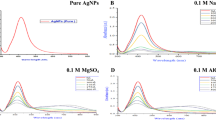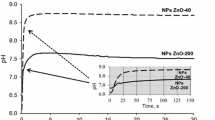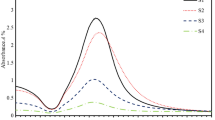Abstract
The study of biological activity of manufactured nanopowders lacks experimental data concerning the influence of electrolyte nature and content on the degree of nanoparticles aggregation in aqueous suspensions. Using the dynamic light scattering technique, it has been shown how the ionic strength (0.0001…100 mM) of mono- and bivalent electrolyte (Na+, Ca2+) solutions influences the size and zeta-potential of Al (90 nm) and Al2O3 (30 nm) nanoparticles. It has been determined that the aggregative effect of counterions decreases when their charge increases. The weaker influence of Ca2+ concentration on the aggregation of both nanoparticles has been demonstrated. For Al2O3 nanoparticles, the stronger influence of Na+ concentration on the size and charge of aggregates has been observed.












Similar content being viewed by others
References
Abercade consulting. Information on the web-site: http://abercade.ru/research/analysis/67.html. Accessed 23 Oct 2014
Aitken RJ, Chaudhry MQ, Boxall ABA, Hull M (2006) Manufacture and use of nanomaterials: current status in the UK and global trends. Occup Med Oxf 56:300–306
Akaighe N, Depner SW, Banerjee S, Sohn M (2013) Transport and deposition of Suwannee river humic acid/natural organic matter formed silver nanoparticles on silica matrices: the influence of solution pH and ionic strength. Chemosphere 92:406–412
Birdi KS (2008) Handbook of surface and colloid chemistry. CRC Press, Boca Raton
Clément L, Hurel C, Marmier N (2013) Toxicity of TiO2 nanoparticles to cladocerans, algae, rotifers and plants—effects of size and crystalline structure. Chemosphere 90:1083–1090
Colvin VL (2003) The potential environmental impact of engineered nanomaterials. Nat Biotechnol 21:1166–1170
Domingos R, Simon D, Hauser C, Wilkinson KJ (2011) Bioaccumulation and Effects of CdTe/CdS quantum dots on chlamydomonas reinhardtii—nanoparticles or the free ions? Environ Sci Technol 45:7664–7669
Doshi R, Braida W, Christodoulatos C, Wazne M, O’Connor G (2008) Nano-aluminum: transport through sand columns and environmental effects on plants and soil communities. Environ Res 106:296–303
Farre M, Gajda-Schrantz K, Kantiani L, Barcelo D (2009) Ecotoxicity and analysis of nanomaterials in the aquatic environment. Anal Bioanal Chem 393:81–95
Guzman KAD, Taylor MR, Banfield JF (2006) Environmental risks of nanotechnology: national nanotechnology initiative funding. Environ Sci Technol 40:1401–1407
Jiang X, Tong M, Lu R, Kim H (2012) Transport and deposition of ZnO nanoparticles in saturated porous media. Colloid Surf A 401:29–37
Karepina EE, Godymchuk AY, Kuznetsov DV, Gusev AA (2014) High physicochemical persistence of aluminum nanoparticles in synthetic body fluids. Adv Mater Res 872:248–256
Li M, Czymmek KJ, Huanga CP (2011) Responses of Ceriodaphnia dubia to TiO2 and Al2O3 nanoparticles: a dynamic nano-toxicity assessment of energy budget distribution. J Hazard Mater 187:502–508
Liu Q, Maroto-Valer MM (2010) Investigation of the pH effect of a typical host rock and buffer solution on CO2 sequestration in synthetic brines. Fuel Process Technol 91:1321–1329
Marques MRC, Loebenberg R, Almukainzi M (2011) Simulated biological fluids with possible application in dissolution testing. Dissolut Technol 118:15–28
Murdock C, Braydich-Stolle L, Schrand AM, Schlager JJ, Hussain SM (2008) Characterization of nanomaterial dispersion in solution prior to in vitro exposure using dynamic light scattering technique. Toxicol Sci 101:239–253
Pakrashi S, Dalai S, Prathna TC, Trivedi S, Myneni R, Raichur AM (2013) Cytotoxicity of aluminium oxide nanoparticles towards fresh water algal isolate at low exposure concentrations. Aquat Toxicol 132:34–45
Rahman T (2013) Transport of aluminum oxide nanoparticles in saturated sand: effects of ionic strength, flow rate, and nanoparticle concentration. Sci Total Environ 463–464:565–571
Römer I, White TA, Baalousha M, Chipman K, Viant MR, Lead JR (2011) Aggregation and dispersion of silver nanoparticles in exposure media for aquatic toxicity tests. J Chromatogr A 1218:4226–4233
Sadiq I, Pakrashi S, Chandrasekaran N, Mukherjee A (2011) Studies on toxicity of aluminum oxide (Al2O3) nanoparticles to microalgae species: Scenedesmus sp. and Chlorella sp. J Nanopart Res 13:3287–3299
Van Hoecke K, De Schamphelaere KAC, Van der Meeren P, Smagghe G, Janssen CR (2011) Aggregation and ecotoxicity of CeO2 nanoparticles in synthetic and natural waters with variable pH, organic matter concentration and ionic strength. Environ Pollut 159:970–976
Wang H, Wick RL, Xing B (2009) Toxicity of nanoparticulate and bulk ZnO, Al2O3 and TiO2 to the nematode Caenorhabditis elegans. Environ Pollut 157:1171–1177
Wang D, Paradelo M, Bradfordc SA, Peijnenburg WJGM, Chua L, Zhou D (2011) Facilitated transport of Cu with hydroxyapatite nanoparticles in saturated sand: effects of solution ionic strength and composition. Water Res 45:5905–5915
Wiesner MR, Lowry GV, Alvarez P, Dionysiou D, Biswas P (2006) Assessing the risks of manufactured nanomaterials. Environ Sci Technol 40:4336–4345
Zhu X, Zhu L, Chen Y, Tian S (2009) Acute toxicities of six manufactured nanomaterials suspensions to Daphnia magna. J Nanopart Res 11:67–75
Acknowledgments
The work was supported by the Ministry of Science and Education of the Russian Federation, Russian Fund for Basic Research (project # 15-03-06528_a) and in the framework of Increase Competitiveness Program of NUST « MISiS ».
Author information
Authors and Affiliations
Corresponding author
Additional information
Guest Editor: Liudmyla Rieznichenko
This article is part of the topical collection on Engineered Bioinspired Nanomaterials
Rights and permissions
About this article
Cite this article
Godymchuk, A., Karepina, E., Yunda, E. et al. Aggregation of manufactured nanoparticles in aqueous solutions of mono- and bivalent electrolytes. J Nanopart Res 17, 211 (2015). https://doi.org/10.1007/s11051-015-3012-7
Received:
Accepted:
Published:
DOI: https://doi.org/10.1007/s11051-015-3012-7




